2001 CHEVROLET SILVERADO ECO mode
[x] Cancel search: ECO modePage 62 of 468

1-49 Where to Put the Restraint
(Regular Cab Pickup)
The child restraint must be secured properly in the right
front passenger seat. If you want to secure a rear
-facing
child restraint in the right front passenger's seat, turn off
the passenger's air bag. See ªAir Bag Off Switchº and
ªSecuring a Child Restraint in the Right Front Seat
Positionº in the Index for more on this, including
important safety information.
CAUTION:
A child in a rear-facing child restraint can be
seriously injured or killed if the right front
passenger's air bag inflates. This is because the
back of the rear
-facing child restraint would be
very close to the inflating air bag. Be sure to turn
off the air bag before using a rear
-facing child
restraint in the right front seat position.
Keep in mind that an unsecured child restraint can move
around in a collision or sudden stop and injure people in
the vehicle
-- even when no child is in it.
Where to Put the Restraint
(Extended Cab Pickup)
Accident statistics show that children are safer if they
are restrained in the rear rather than the front seat.
General Motors, therefore, recommends that child
restraints be secured in the rear seat, including an infant
riding in a rear
-facing infant seat, a child riding in a
forward
-facing child seat and an older child riding in a
booster seat. There is limited space in the rear seating
area of an extended cab model. If you want to secure a
child restraint in a rear seating position of an extended
cab model, especially in the rear center position, be sure
to study the instructions that came with your child
restraint to see if there is enough room to secure your
seat properly.
If a forward
-facing child seat must be secured in the
vehicle's right front seat, the seat should be moved back
as far as possible. However, it is better to secure the
restraint in a rear seat.
If you want to secure a rear
-facing child restraint in the
right front passenger's seat, turn off the passenger's air
bag. See ªAir Bag Off Switchº and ªSecuring a Child
Restraint in the Right Front Seat Positionº in the Index
for more on this, including important safety information.
Page 86 of 468
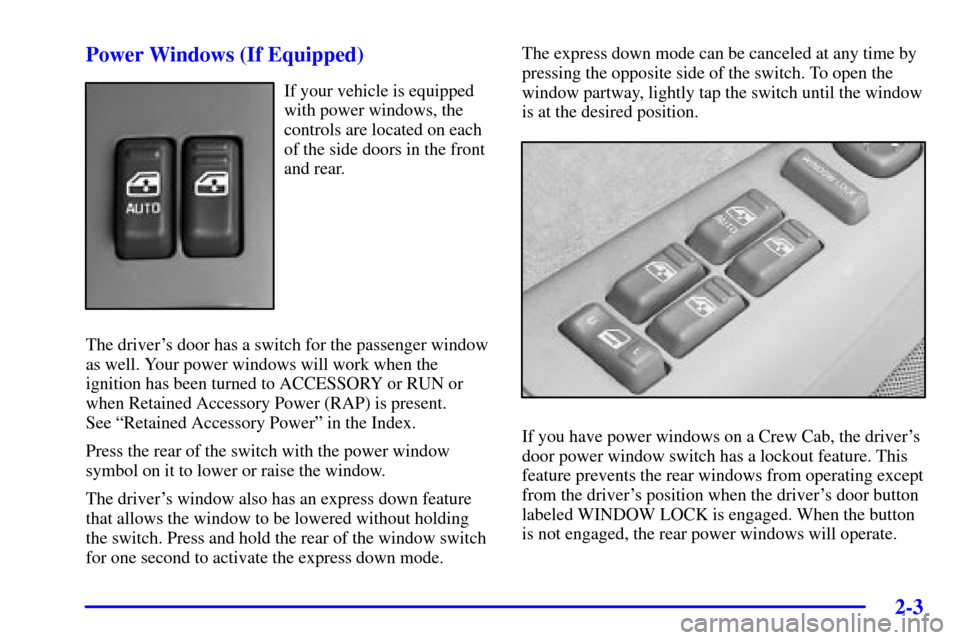
2-3
Power Windows (If Equipped)
If your vehicle is equipped
with power windows, the
controls are located on each
of the side doors in the front
and rear.
The driver's door has a switch for the passenger window
as well. Your power windows will work when the
ignition has been turned to ACCESSORY or RUN or
when Retained Accessory Power (RAP) is present.
See ªRetained Accessory Powerº in the Index.
Press the rear of the switch with the power window
symbol on it to lower or raise the window.
The driver's window also has an express down feature
that allows the window to be lowered without holding
the switch. Press and hold the rear of the window switch
for one second to activate the express down mode. The express down mode can be canceled at any time by
pressing the opposite side of the switch. To open the
window partway, lightly tap the switch until the window
is at the desired position.
If you have power windows on a Crew Cab, the driver's
door power window switch has a lockout feature. This
feature prevents the rear windows from operating except
from the driver's position when the driver's door button
labeled WINDOW LOCK is engaged. When the button
is not engaged, the rear power windows will operate.
Page 91 of 468

2-8
If your vehicle has this
power door lock switch,
press the bottom of the
switch on either front door
to lock all the doors at once.
Press the top of the switch to unlock all the doors
at once.
The power door locks will operate at any time without
the ignition being on.
The power door locks will also automatically lock when
the vehicle reaches 15 mph (24 km/h). To unlock the
doors, refer to the instructions listed previously. The
automatic locking feature can be disabled, if you prefer.
See ªProgrammable Automatic Door Locksº in the
following text.
Operating the power locks may interact with the
theft
-deterrent system (if equipped). See ªContent
Theft
-Deterrentº in the Index.
Programmable Automatic Door Locks
Your vehicle is equipped with an auto lock/unlock feature
which enables you to program your power door locks.
Your vehicle left the factory programmed to have the
automatic lock feature lock all the doors when the
vehicle speed is greater than 15 mph (24 km/h) for two
seconds, and then unlock all the doors once the key is
removed from the ignition. The following instructions
detail how to program your door locks.
To enter the program mode you need to do the following:
1. Beginning with the ignition in OFF, pull back on the
turn signal/multifunction lever all the way toward
you and hold it while you perform the next step.
2. Turn your key to ON and OFF twice. Then, with the
key in OFF, release the turn signal/multifunction
lever. Once you do this, you will hear the lock switch
lock and unlock.
3. You are now ready to program the automatic door
locks. Select one of the following four programming
options and follow the instructions. You will have
ten seconds to begin programming. If you exceed the
ten second limit, the locks will automatically lock and
unlock to indicate you have left the program mode.
Page 111 of 468
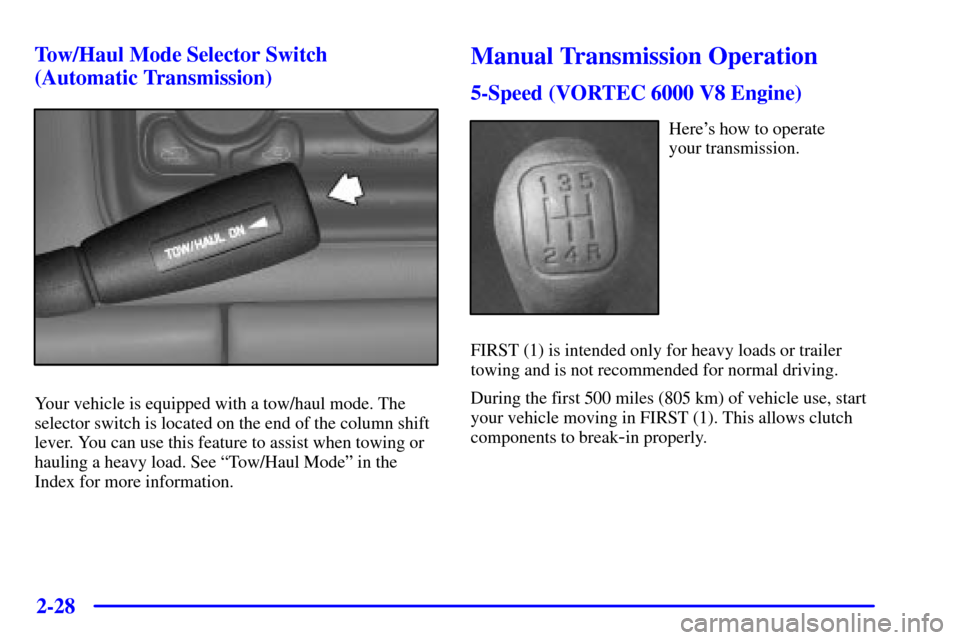
2-28
Tow/Haul Mode Selector Switch
(Automatic Transmission)
Your vehicle is equipped with a tow/haul mode. The
selector switch is located on the end of the column shift
lever. You can use this feature to assist when towing or
hauling a heavy load. See ªTow/Haul Modeº in the
Index for more information.
Manual Transmission Operation
5-Speed (VORTEC 6000 V8 Engine)
Here's how to operate
your transmission.
FIRST (1) is intended only for heavy loads or trailer
towing and is not recommended for normal driving.
During the first 500 miles (805 km) of vehicle use, start
your vehicle moving in FIRST (1). This allows clutch
components to break
-in properly.
Page 120 of 468
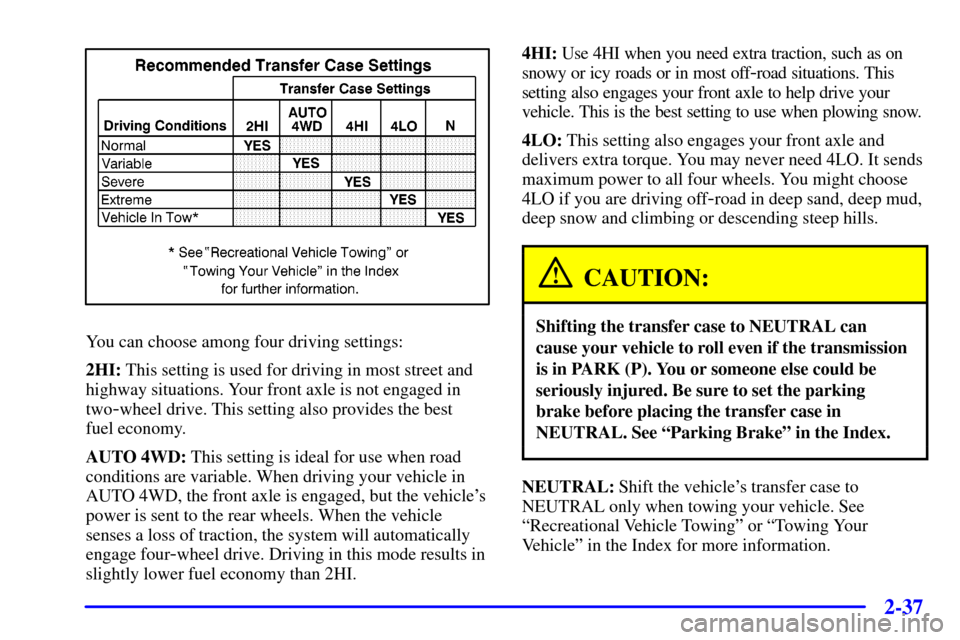
2-37
You can choose among four driving settings:
2HI: This setting is used for driving in most street and
highway situations. Your front axle is not engaged in
two
-wheel drive. This setting also provides the best
fuel economy.
AUTO 4WD: This setting is ideal for use when road
conditions are variable. When driving your vehicle in
AUTO 4WD, the front axle is engaged, but the vehicle's
power is sent to the rear wheels. When the vehicle
senses a loss of traction, the system will automatically
engage four
-wheel drive. Driving in this mode results in
slightly lower fuel economy than 2HI.4HI: Use 4HI when you need extra traction, such as on
snowy or icy roads or in most off
-road situations. This
setting also engages your front axle to help drive your
vehicle. This is the best setting to use when plowing snow.
4LO: This setting also engages your front axle and
delivers extra torque. You may never need 4LO. It sends
maximum power to all four wheels. You might choose
4LO if you are driving off
-road in deep sand, deep mud,
deep snow and climbing or descending steep hills.
CAUTION:
Shifting the transfer case to NEUTRAL can
cause your vehicle to roll even if the transmission
is in PARK (P). You or someone else could be
seriously injured. Be sure to set the parking
brake before placing the transfer case in
NEUTRAL. See ªParking Brakeº in the Index.
NEUTRAL: Shift the vehicle's transfer case to
NEUTRAL only when towing your vehicle. See
ªRecreational Vehicle Towingº or ªTowing Your
Vehicleº in the Index for more information.
Page 143 of 468
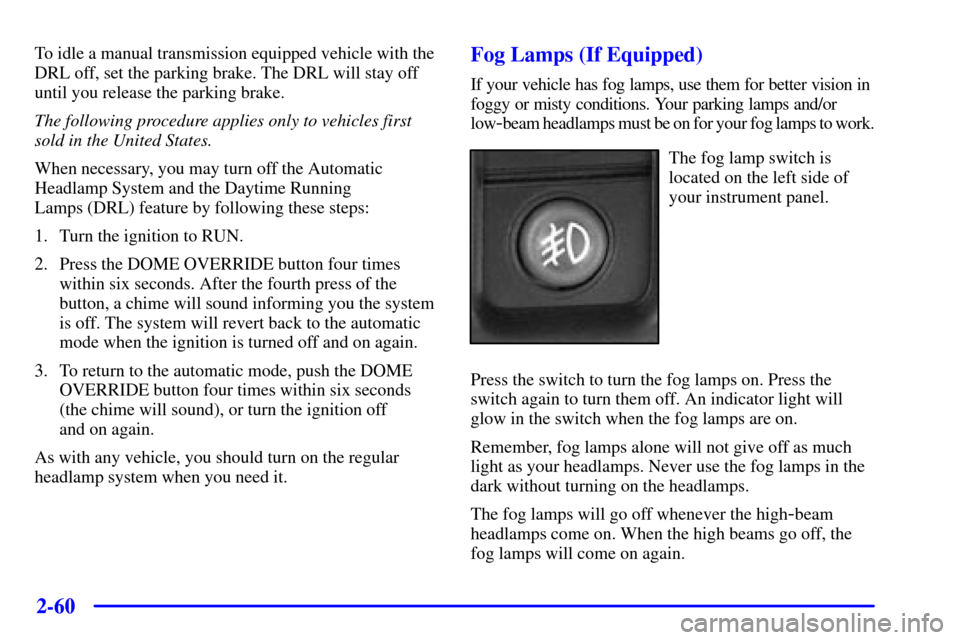
2-60
To idle a manual transmission equipped vehicle with the
DRL off, set the parking brake. The DRL will stay off
until you release the parking brake.
The following procedure applies only to vehicles first
sold in the United States.
When necessary, you may turn off the Automatic
Headlamp System and the Daytime Running
Lamps (DRL) feature by following these steps:
1. Turn the ignition to RUN.
2. Press the DOME OVERRIDE button four times
within six seconds. After the fourth press of the
button, a chime will sound informing you the system
is off. The system will revert back to the automatic
mode when the ignition is turned off and on again.
3. To return to the automatic mode, push the DOME
OVERRIDE button four times within six seconds
(the chime will sound), or turn the ignition off
and on again.
As with any vehicle, you should turn on the regular
headlamp system when you need it.Fog Lamps (If Equipped)
If your vehicle has fog lamps, use them for better vision in
foggy or misty conditions. Your parking lamps and/or
low
-beam headlamps must be on for your fog lamps to work.
The fog lamp switch is
located on the left side of
your instrument panel.
Press the switch to turn the fog lamps on. Press the
switch again to turn them off. An indicator light will
glow in the switch when the fog lamps are on.
Remember, fog lamps alone will not give off as much
light as your headlamps. Never use the fog lamps in the
dark without turning on the headlamps.
The fog lamps will go off whenever the high
-beam
headlamps come on. When the high beams go off, the
fog lamps will come on again.
Page 171 of 468

2-88
Readings in the low warning zone may occur when a
large number of electrical accessories are operating in
the vehicle and the engine is left at an idle for an
extended period. This condition is normal since the
charging system is not able to provide full power at
engine idle. As engine speeds are increased, this
condition should correct itself as higher engine speeds
allow the charging system to create maximum power.
You can only drive for a short time with the reading in
either warning zone. If you must drive, turn off all
unnecessary accessories.
Readings in either warning zone indicate a possible
problem in the electrical system. Have the vehicle
serviced as soon as possible.
Shift Light (If Equipped)
This light is used on
some models with
manual transmissions.
The SHIFT indicator light will help you get the best fuel
economy. See ªShift Lightº or ªShift Speedsº in the
index for more information.
Brake System Warning Light
With the ignition on, the brake system warning light will
flash when you set the parking brake. The light will flash
if the parking brake doesn't release fully. If you try to
drive with the parking brake engaged, a chime will sound
when the vehicle speed is greater than 3 mph (5 km/h).
Your vehicle's hydraulic brake system is divided into
two parts. If one part isn't working, the other part can
still work and stop you. For good braking, though, you
need both parts working well.
If the warning light comes on, there could be a brake
problem. Have your brake system inspected right away.
United States Canada
Page 199 of 468
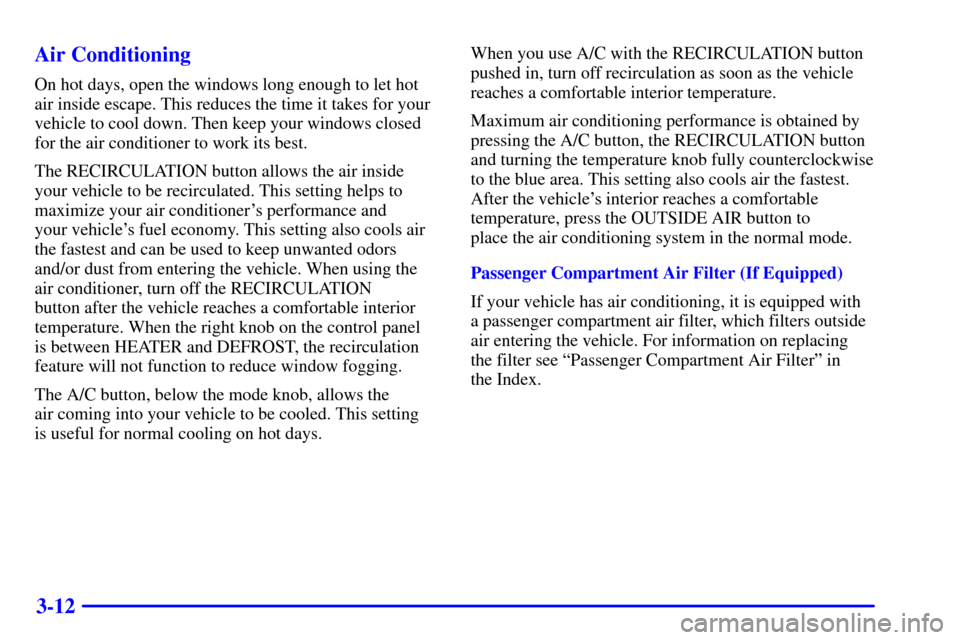
3-12 Air Conditioning
On hot days, open the windows long enough to let hot
air inside escape. This reduces the time it takes for your
vehicle to cool down. Then keep your windows closed
for the air conditioner to work its best.
The RECIRCULATION button allows the air inside
your vehicle to be recirculated. This setting helps to
maximize your air conditioner's performance and
your vehicle's fuel economy. This setting also cools air
the fastest and can be used to keep unwanted odors
and/or dust from entering the vehicle. When using the
air conditioner, turn off the RECIRCULATION
button after the vehicle reaches a comfortable interior
temperature. When the right knob on the control panel
is between HEATER and DEFROST, the recirculation
feature will not function to reduce window fogging.
The A/C button, below the mode knob, allows the
air coming into your vehicle to be cooled. This setting
is useful for normal cooling on hot days. When you use A/C with the RECIRCULATION button
pushed in, turn off recirculation as soon as the vehicle
reaches a comfortable interior temperature.
Maximum air conditioning performance is obtained by
pressing the A/C button, the RECIRCULATION button
and turning the temperature knob fully counterclockwise
to the blue area. This setting also cools air the fastest.
After the vehicle's interior reaches a comfortable
temperature, press the OUTSIDE AIR button to
place the air conditioning system in the normal mode.
Passenger Compartment Air Filter (If Equipped)
If your vehicle has air conditioning, it is equipped with
a passenger compartment air filter, which filters outside
air entering the vehicle. For information on replacing
the filter see ªPassenger Compartment Air Filterº in
the Index.